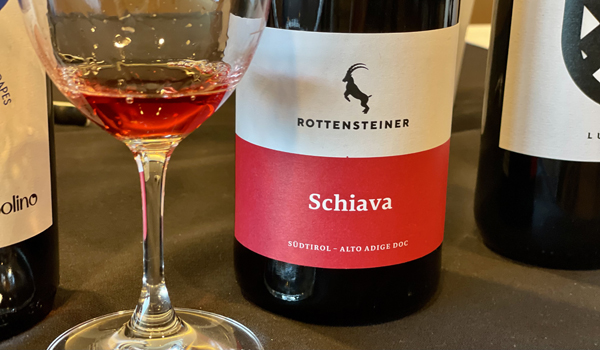2024 Rottensteiner, Schiava, Alto Adige DOC, Italy.
The delicate ruby hued and light bodied Rottensteiner Schiava is a more subtle version of this varietal without too much juicy punch like fruitiness, showing a fine mineral tone, rose petal aromatics and a strawberry, cherry and plum fruited palate, along with a hint of each, spice and fennel notes. Schiava, a bit like Frappato in Sicily and Freisa in Piedmonte, is native to the Alto Adige in the Sudtirol, where it usually is made as a single varietal wine. Schiava though is a permitted variety in several Denominazione di Origine Controllata (DOC)s including the Santa Maddalena DOC located east of the city of Bolzano in the South Tyrol/Alto Adige region, which actually might be the best expression of Schiava, where it is usually 90% of the blend, with a little bit of the very dark Lagrein and or Pinot Noir. As this Rottensteiner Schiava, sourced from pergola trained vines set on sandy porphyry soils, opens up you get burnt orange, mountain herbs and framboise notes and it gets more texturally pleasing. The Rottensteiner winery near the city of Bolzano is all new to me and looks focused on approachable wines that show off the Alto Adige’s history, terroir and purity of native varietals, which includes Pinot Grigio, Pinot Blanco, Müller Thurgau, Sylvaner, Lagrein and this Schiava.
Schiava is an Italian name used to refer to several grape varieties common to the Trentino and Alto Adige regions of northern Italy. It is said that while the grape is likely northern Italian in origin, the synonym Schiava is closely related to the Italian word for “Slave” and may hint to the type of vine plant in Roman times (forced by pruning) like being Pergola trained. Old records show that the grape has been growing in the Trentino-Alto Adige region since at least the 13th century. Schiva, also known as Trollinger or Vernatsch, is a red German/Italian wine grape variety that was likely first originally cultivated in the wine regions of South Tyrol and Trentino in the Alto Adige, high up in the Dolomites, but today it is mostly grown in Germany, and mainly in the Württemberg wine region of Baden-Württemberg. Madeline Puckette of the Wine Folly says Schiava is a light-bodied red wine (like Pinot Noir) with aromas of cotton candy, strawberry, bubblegum, and lemonhead candy. Interestingly, old plantings of Schiava in California were called Black Hamburg, but because of the lighter color and lack of complexity, it never saw much success in table wine here. This stainless steel fermented and aged Shiava is great as a starter wine and is like Gamay, good served slightly chilled.
($22 Est.) 90 Points, grapelive
